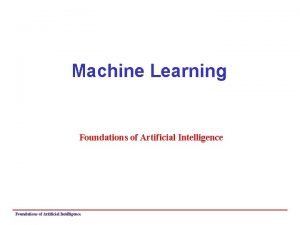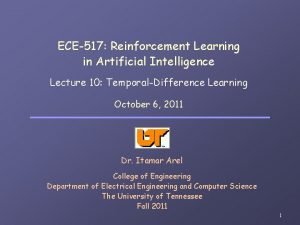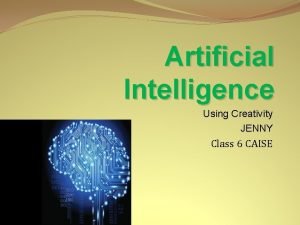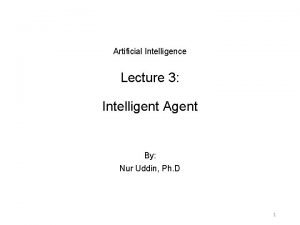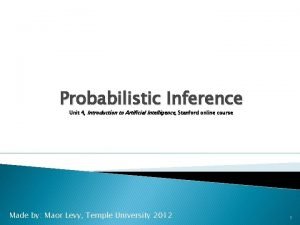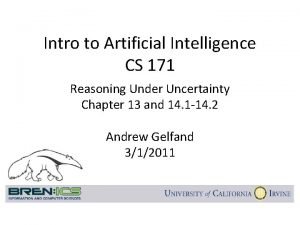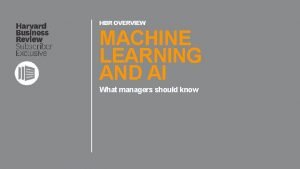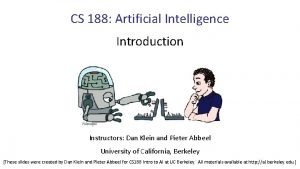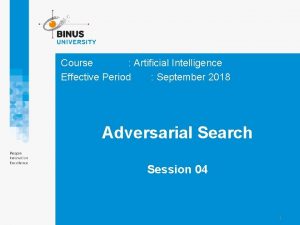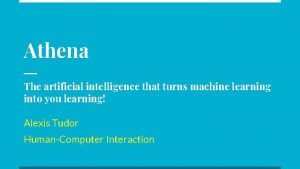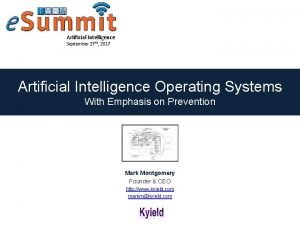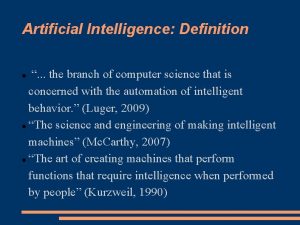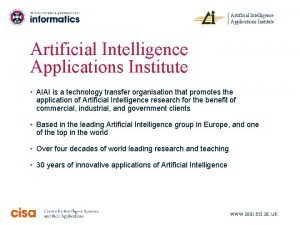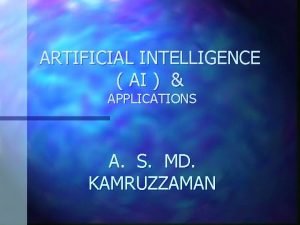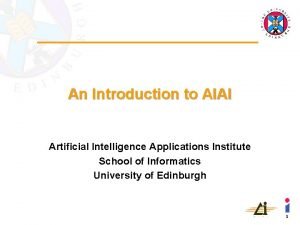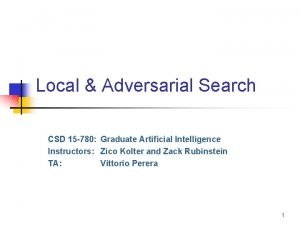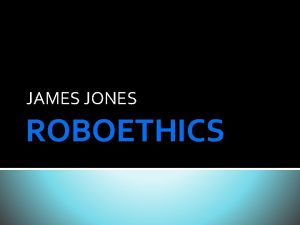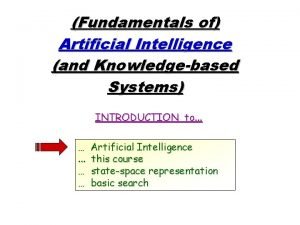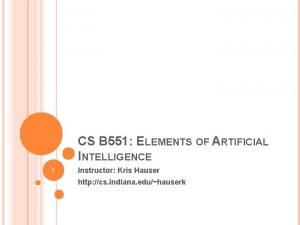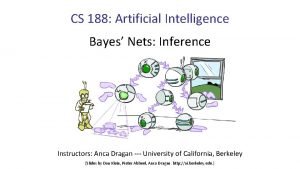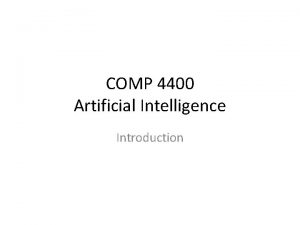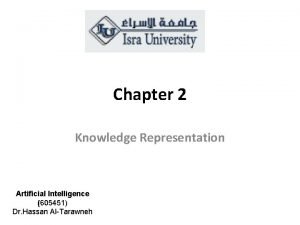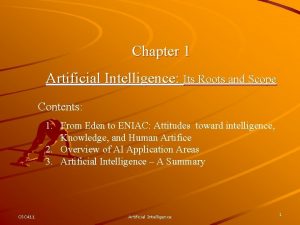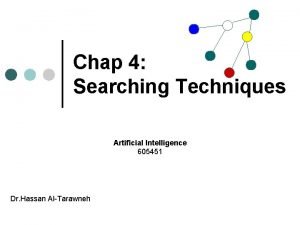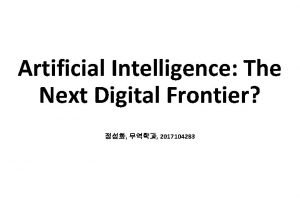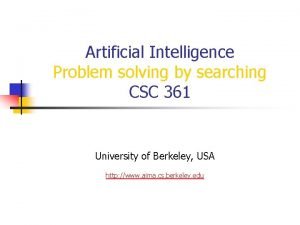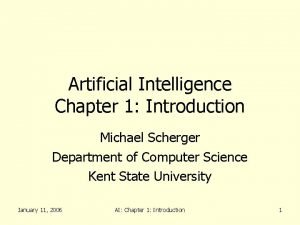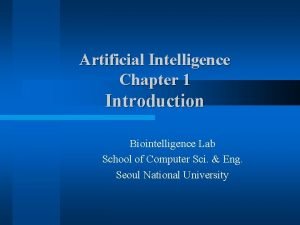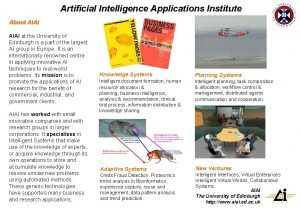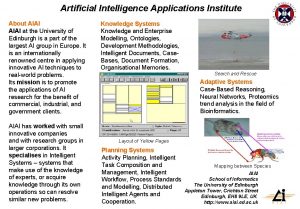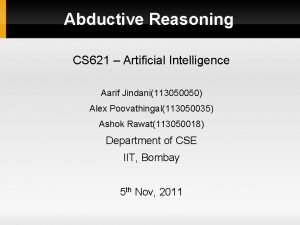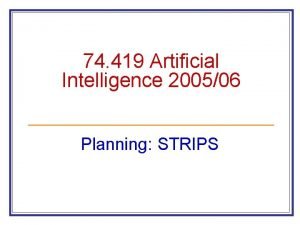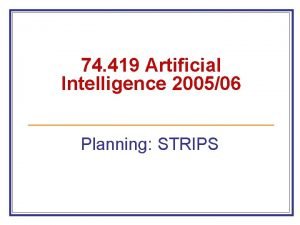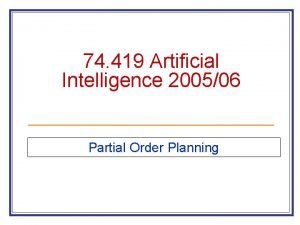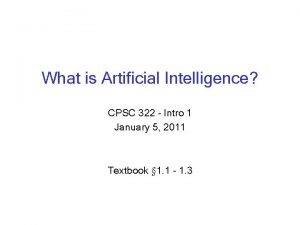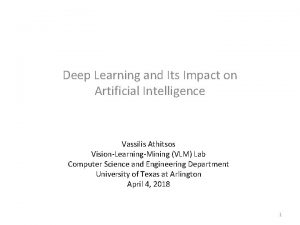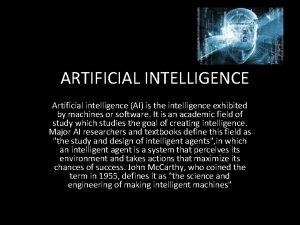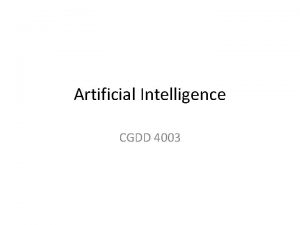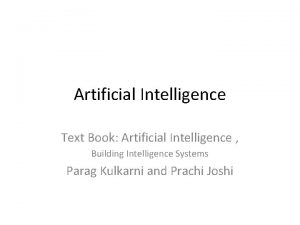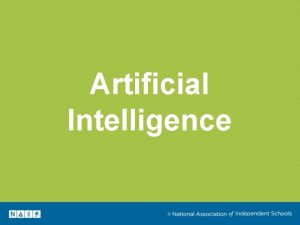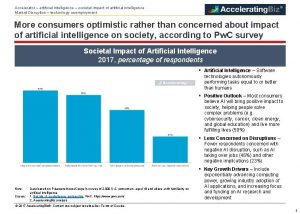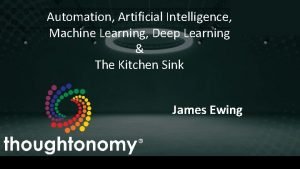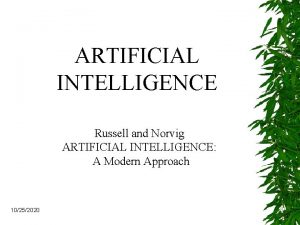Deep Learning and Its Impact on Artificial Intelligence

































































![References [Bol 16] Tolga Bolukbasi, Kai-Wei Chang, James Y. Zou, Venkatesh Saligrama, Adam Tauman References [Bol 16] Tolga Bolukbasi, Kai-Wei Chang, James Y. Zou, Venkatesh Saligrama, Adam Tauman](https://slidetodoc.com/presentation_image_h/aa3efd0193e359a32d57b59e6f0bee9f/image-66.jpg)
- Slides: 66

Deep Learning and Its Impact on Artificial Intelligence Vassilis Athitsos Vision-Learning-Mining (VLM) Lab Computer Science and Engineering Department University of Texas at Arlington April 4, 2018 1

What Does the Title Mean? • “Deep Learning and Its Impact on Artificial Intelligence”. • What do we mean by: – Artificial Intelligence. – Machine Learning. – Deep Learning. 2

Artificial Intelligence • In Sci-Fi: – Robots that think and act intelligently, often surpassing human performance. • Data in Star Trek. • C-3 P 0 in Star Wars… – All-knowing computers. • In real life: artificial intelligence is the science of designing systems (hardware or software) that can: – perceive their environment, and – have specific goals, and – use reasoning to improve their chances of achieving those goals. 3

A Simple Example: Blocks World • Studied in the 1960 s-1970 s. • There are cubic blocks on the table, in a specific arrangement. • We want a different arrangement. • The system figures out a sequence of actions to accomplish that goal. • Such a system must: – Perceive its environment. – Be able to come up with a plan to achieve its goal. – Be able to perform the required actions. initial state A B C goal A B C 4

A Simple Example: Blocks World • Studied in the 1960 s-1970 s. • There are cubic blocks on the table, in a specific arrangement. • We want a different arrangement. • The system figures out a sequence of actions to accomplish that goal. • Such a system must: – Perceive its environment. – Be able to come up with a plan to achieve its goal. – Be able to perform the required actions. initial state A B C goal A B C Not quite as impressive as Data or C-3 PO… 5

AI Progress • AI systems have been getting more complex, more “intelligent”. – – – 1960 s-1970 s: Blocks world. 1997: Beat the world champion in chess. 1990 s: commercial speech recognition systems. 2000 s: face detectors in consumer cameras. 2015: highly accurate machine translations from English to French, and for other pairs of languages with large amounts of training data. 6

What Is Machine Learning? • We focus on supervised learning. – The computer is presented with training examples, consisting of example inputs and their desired outputs. • The job of the “supervisor” is to prepare those training examples. – Goal: learn a general function that maps inputs to outputs. 7

Supervised Learning • Example: recognizing the digits of zip codes. – The training set consists of images of digits and the names of those digits. example inputs one two three four five six seven eight nine zero desired outputs (class labels) 8

Supervised Learning • Example: face recognition – The training set consists of images of faces and the IDs of those faces. example inputs Person Person Person 534 789 956 120 521 457 917 398 017 desired outputs (class labels) 9

AI and Machine Learning • Machine Learning is a branch of Artificial Intelligence. • People have been producing AI systems without using machine learning. • How can you do AI without learning? – Use rules: • Chess: make sure your pieces are not threatened, capture the highest value piece if possible. . . – Use search: • Blocks world: explore various sequences of actions, find the one that achieves the goal. • Chess: try billions of sequences of moves, find the one that leads to the most advantageous state. 10

AI and Machine Learning • Examples of AI systems over the year: NO LEARNING, SEARCH BASED - 1960 s: blocks world NO LEARNING, SEARCH BASED - 1997: beat the world champion in chess. LEARNING – 1990 s: commercial speech recognition systems. LEARNING – 2000 s: face detectors in consumer cameras. DEEP LEARNING – 2010 s: highly accurate machine translations. DEEP LEARNING - 2015: world championship level play in Go. 11

Why Machine Learning? • Machine Learning has dominated AI in recent years. • Reasons: – More efficient for humans: coming up with manually hardcoded rules takes time, and must be done every time, for each new problem. – More efficient for computers: directly mapping inputs to outputs can be far more efficient than searching through a huge number of possible outputs, and waiting to stumble upon the right output. – More accurate: learning from lots of examples consistently beats systems that are rule-based or search-based. 12

Shallow Learning • To understand what is “deep” about deep learning, we should see how things were done back in the age of “shallow” learning. • Example: speech recognition in the old days. 13

Shallow Learning • To understand what is “deep” about deep learning, we should see how things were done back in the age of “shallow” learning. • Example: speech recognition in the old days. Audio Feature Extraction Phoneme-Level Recognition Word-Level Recognition Sentence. Level Recognition Handcrafted features Learning problem #1 Learning problem #2 Learning problem #3 14

Shallow Learning • To understand what is “deep” about deep learning, we should see how things were done back in the age of “shallow” learning. • Example: speech recognition in the old days. Audio Feature Extraction Phoneme-Level Recognition Word-Level Recognition Sentence. Level Recognition Handcrafted features Learning problem #1 Learning problem #2 Learning problem #3 • The big problem was decomposed into smaller problems. • A lot of manual design was needed for this decomposition. 15

Shallow vs. Deep Learning Audio Feature Extraction Phoneme-Level Recognition Word-Level Recognition Sentence. Level Recognition Handcrafted features Learning problem #1 Learning problem #2 Learning problem #3 Deep Learning Module Sentence. Level Recognition • In deep learning, we try to build a single “deep” model for the entire endto-end processing that maps input to output. • Using a deep model eliminates the need to manually define and train 16 separate subsystems for different parts of the process.

Deep Learning and Neural Networks • Deep learning models are neural networks. • However, neural networks have been around since the 1960 s. – The deep learning craze started around 2010. • So, deep learning and neural networks are related, but not synonyms. • First, we will look at the basic definition of neural networks. • Then, we will see how neural networks are used at deep learning. 17

Perceptrons • Perceptrons are the building blocks of neural networks. • A single perceptron takes a multidimensional input, and produces a single number as output. • What is “learnable” in a perceptron is a set of weights. – Each weight corresponds to a dimension of the input vector. 18

Perceptrons • 19

Activation Functions • 20

Activation Functions • 21

Perceptrons and Neurons • Perceptrons are inspired by neurons. – Neurons are the cells forming the nervous system, and the brain. – Neurons somehow compute a weighted sum of their inputs, and if the sum exceeds a threshold, they "fire". • Since brains are "intelligent", AI researchers have been hoping for a long time that perceptron-based systems can be used to model intelligence. 22

Example: The AND Perceptron • • Suppose we use the step function for activation. Suppose boolean value false is represented as number 0. Suppose boolean value true is represented as number 1. Then, the perceptron below computes the boolean AND function: false AND false = false AND true = false true AND false = false true AND true = true 23

Example: The AND Perceptron • false AND false = false AND true = false true AND false = false true AND true = true 24

Example: The AND Perceptron • false AND false = false AND true = false true AND false = false true AND true = true 25

Example: The AND Perceptron • false AND false = false AND true = false true AND false = false true AND true = true 26

Example: The AND Perceptron • false AND false = false AND true = false true AND false = false true AND true = true 27

Example: The OR Perceptron • • Suppose we use the step function for activation. Suppose boolean value false is represented as number 0. Suppose boolean value true is represented as number 1. Then, the perceptron below computes the boolean OR function: false OR false = false OR true = true OR false = true OR true = true 28

Example: The NOT Perceptron • • Suppose we use the step function for activation. Suppose boolean value false is represented as number 0. Suppose boolean value true is represented as number 1. Then, the perceptron below computes the boolean NOT function: NOT(false) = true NOT(true) = false 29

The XOR Function false XOR false = false XOR true = true XOR false = true XOR true = false • As before, we represent false with 0 and true with 1. • The figure shows the four input points of the XOR function. – green corresponds to output value true. – red corresponds to output value false. • The two classes (true and false) are not linearly separable. • Therefore, no perceptron can compute the XOR function. 30

Neural Networks • A neural network is built using perceptrons as building blocks. • The inputs to some perceptrons are outputs of other perceptrons. • Here is an example neural network computing the XOR function. Unit 3 Unit Output: 5 Unit 4 31

Neural Network Layers • • Usually neural networks are organized into layers. The input layer is the initial layer of input units. The output layer is at the end. Zero, one or more hidden layers can be between the input and output layers. Input layer Hidden layers Output layer 32

Neural Network Layers • • Each hidden layer's inputs are outputs from the previous layer. Each hidden layer's outputs are inputs to the next layer. The first hidden layer's inputs come from the input layer. The last hidden layer's outputs are inputs to the output layer. Input layer Hidden layers Output layer 33

Computing the Output • Input layer Hidden layers Output layer 34

Computing the Output • Input layer Hidden layers Output layer 35

What Neural Networks Can Compute • Neural networks with two hidden layers can compute any mathematical function. • However, there are some catches: • How do we find the number of units per layer? • How do we find the right weights? Input layer Hidden layers Output layer 36

Neural Networks and Deep Learning • Deep Learning models are essentially deep neural networks. • In other words, they are neural networks with a large number of hidden layers. • In the older days, neural networks might include one or two hidden layers. • These days they may include over 100 hidden layers. Input layer Hidden layers - - Output layer - - - 37

Deep vs. Shallow Networks • 2 hidden layers are sufficient for modeling any function. • However, the number of perceptrons in each layer may need to be extremely large. • Deeper networks may need a smaller total amount of perceptrons for the same task. – Layers allow for modularization/factorization of a learning problem. Input layer Hidden layers - - Output layer - - - 38

Training a Neural Network • 39

On Training Neural Networks • Backpropagation converges to a local optimum. – It is unlikely to find the universally best solution. • The billion dollar question: how likely is training to converge to a useful solution? 40

On Training Neural Networks • Before the 2010 s, most people were skeptical about the practicality of training large neural networks. – Even shallow neural networks had a large number of parameters. – It took lots of data and lots of time to estimate good values for such networks. – Deeper networks made that problem even harder, because they had even more parameters. • Now we know that deep neural networks are indeed trainable, actually better than other models. – Prerequisite: a sufficient (i. e. , very large) amount of training data. 41

Neural Networks, pre-2010 • Before 2010, neural networks were usually not the first choice for people doing research in AI (computer vision, speech recognition, …). • Other methods were more popular, gave usually better results: – – Boosting methods. Decision trees and random forests. Support vector machines. Probabilistic graphical models (e. g. , Hidden Markov Models for speech recognition). 42

Post 2010 – What Changed • Some deep learning methods that are now popular were known in the 1990 s. – Convolutional Neural Networks proposed by Yann Le. Cun in the 1990 s [Le. Cun 95]. • Limitations in hardware did not allow using and evaluating such methods with sufficient training data. • Improved hardware (CPUs, GPUs, RAM) eventually allowed experiments with sufficiently large datasets. • In computer vision, deep neural networks started outperforming other methods by large margins around 2012. 43

Post 2010 – What Changed • Initial successes started a positive feedback loop: – More researchers started working on improving deep neural networks. – New improvements led to even better results. – Even better results encouraged even more people to start using deep neural networks… • Continuing improvements in hardware, and continuing algorithmic improvements allow the use of ever deeper models, with even better results: – 7 hidden layers in 2012. – 152 hidden layers in 2016. 44

Performance vs. Size of Data • Pre-2010, relatively smaller training sets: – Other machine learning methods tended to outperform neural network methods. • Post-2010, larger training sets: – Deep neural networks get a big bump in accuracy, and outperform other methods. – Compared to other methods, deep neural networks are more capable of taking advantage of large amounts of data. 45

Convolutional Neural Networks • Convolutional Neural Networks (CNNs) are the dominant paradigm in deep learning models for computer vision. – Originally proposed by Yann Le. Cun in the 1990 s [Le. Cun 95]. • Hidden layers perform convolutions on their input. – Convolutional layers have a far smaller number of parameters, compared to fullyconnected layers. – Fewer parameters can be trained with smaller amounts of data. Credit: figure from apple. com developer website. 46

CNN Visualization • Visualization of a deep neural network trained with face images. – Credit for feature visualizations: [Lee 09] Honglak Lee, Roger Grosse, Rajesh Ranganath and Andrew Y. Ng. , ICML 2009. Input Early layers, extract simple features. Middle layers, model shape parts. Last layers, model (almost) entire faces. Output 47

Transfer Learning with CNNs • Suppose you have a very large training set: – with millions images – thousands of categories – thousands of examples per category. • Suppose you only want to recognize two classes: – Images of cats. – Images of dogs. • However, you only have few example images of cats and dogs. • What do you do? 48

Transfer Learning with CNNs • Old-fashioned way: – Learn some classifier using your few training examples of cats and dogs. – Typically limited accuracy, due to small number of training examples. 49

Transfer Learning with CNNs • The deep learning way: transfer learning. – Learn a deep model on your large datasets of millions of examples and thousands of categories. – Replace the last layer of the deep model, that recognizes those thousands of categories, with a new layer that only recognizes cats and dogs. – Train the new layer using the few examples of cats and dogs. Input We replace and retrain this last layer (or a few of the last layers). 50

Transfer Learning with CNNs • This is called transfer learning. – We transfer knowledge extracted from one large dataset to another small dataset. – The layers we keep have learned useful features (shape parts that are building blocks of objects) from millions of examples. – We just create a new last layer, that learns how to distinguish cats and dogs based on those useful features. Input We replace and retrain this last layer (or a few of the last layers). 51

Success Stories – Image. Net • Task: classify each image into over 1000 categories. • Before deep learning: 25% error rate. • 2012: deep learning model, 16% error rate. – Had a huge impact in the computer vision community. – Reference: [Kriz 12] Alex Krizhevsky, Ilya Sutskever, and Geoffrey E. Hinton, NIPS 2012. • Now: under 5% error rate. Images from the Image. Net dataset. 52

Success Stories – Face Recognition • 99. 6% accuracy in recognizing a dataset of 5, 000 individuals. – Reference: [Kem 16] Ira Kemelmacher-Shlizerman, Steve Seitz, Daniel Miller, Evan Brossard, CVPR 2016. • Face verification used for unlocking smartphones and laptops. • Social media websites identify people in photos. – Google Photos, Facebook… Images from the Mega. Face dataset. 53

Success Stories - Translation • Google Translate switched in 2015 to a deep learning model. • Accuracies improved significantly, according to ratings provided by humans (a score of 6 means “perfect”). From To Previous model Deep learning Human translation English Spanish 4. 885 5. 428 5. 504 English French 4. 932 5. 295 5. 496 English Chinese 4. 035 4. 594 4. 987 Spanish English 4. 872 5. 187 5. 372 French English 5. 046 5. 343 5. 404 Chinese English 3. 694 4. 263 4. 636 Results from: [Wu 16] Yonghui Wu et al. , “Google's Neural Machine Translation System: Bridging the Gap between Human and Machine Translation”, at arxiv. org, 2016. 54

Limitations – Amounts of Data • Deep learning methods do great when lots of training data is available. • However, it is often hard to find sufficient amounts of data. – Example: for face recognition, Google uses a proprietary dataset with tens of millions of individuals. As a university, we cannot compete with that. – Example: for American Sign Language recognition, NO current dataset is sufficiently comprehensive to train an acceptably accurate general-purpose translation system. • Humans need less data to learn, so there is room for improvement. 55

Limitations - Accuracy • In most tasks, accuracy is still far from being on par with human accuracy. Just a few examples: • Mistakes in face detection: • Mistakes in machine translation: Examples from Mega. Face website – Google Translate, input in Greek: • Δε φτάνει να θέλεις να κάνεις κάτι, πρέπει και να το μπορείς. – Google Translate output: • You do not want to do something, you have to. 56

Limitations - Accuracy • In most tasks, accuracy is still far from being on par with human accuracy. Just a few examples: • Mistakes in face detection: • Mistakes in machine translation: Examples from Mega. Face website – Google Translate, input in Greek: • Δε φτάνει να θέλεις να κάνεις κάτι, πρέπει και να το μπορείς. – Google Translate output: • You do not want to do something, you have to. – My translation: • It is not enough to want to do something, you also have to be able 57 to do it.

Limitations - Bias • Example: black people labeled as gorillas by Google photos. Picture retrieved from https: //twitter. com/jackyalcine/status/615329515909156865 See articles at Mashable, New York Magazine, The Guardian. 58

Limitations - Bias • Example: a language model was trained to complete analogies, such as: – Input: Paris is to France as Rome is to ? ? ? – Output: Italy. • That model provided some heavily biased answers: – Input: Man is to computer programmer as woman is to ? ? ? – Output: 59

Limitations - Bias • Example: a language model was trained to complete analogies, such as: – Input: Paris is to France as Rome is to ? ? ? – Output: Italy. • That model provided some heavily biased answers: – Input: Man is to computer programmer as woman is to ? ? ? – Output: homemaker. 60

Limitations - Bias • Example: a language model was trained to complete analogies, such as: – Input: Paris is to France as Rome is to ? ? ? – Output: Italy. • That model provided some heavily biased answers: – – Input: Man is to computer programmer as woman is to ? ? ? Output: homemaker. Input: Man is to doctor as woman is to ? ? ? Output: 61

Limitations - Bias • Example: a language model was trained to complete analogies, such as: – Input: Paris is to France as Rome is to ? ? ? – Output: Italy. • That model provided some heavily biased answers: – – Input: Man is to computer programmer as woman is to ? ? ? Output: homemaker. Input: Man is to doctor as woman is to ? ? ? Output: Nurse. Reference: [Bol 16] Tolga Bolukbasi, Kai-Wei Chang, James Y. Zou, Venkatesh Saligrama, Adam Tauman Kalai: “Man is to Computer Programmer as Woman is to Homemaker? 62 Debiasing Word Embeddings. ” NIPS 2016: 4349 -4357

Limitations - Bias • Bias is a big problem, that needs to be overcome as deep learning models are used to make decisions that affect humans. – Systems that are trained with black dogs and white cats think that a white dog is a cat. – Similarly, systems trained based on human decisions, learn human biases. • Can lead to unfair decisions for loans, release from prison, college admissions, employment… • An exacerbating factor is the lack of explainability of the output of deep learning models. – Decisions are influenced by millions of perceptrons, it is hard to tell if an output was influenced by bias. 63

Conclusions • Deep learning models are “deep” in two aspects: – In terms of functionality: they are end-to-end models, directly mapping input to output. – In terms of design: deep neural networks with many hidden layers. • For many years, people were skeptical about the practicality of training large neural networks. • Better hardware, more memory, and more data have demonstrated that deep neural networks significantly outperform other machine learning methods in many tasks. • Many success stories, many commercial applications: – Object recognition, face recognition, machine translation, speech recognition… • Still, lots of room for improvement: – Improving accuracy, training with fewer examples, avoiding bias… 64

Conclusions • 20 years ago, computer vision and machine learning were not that relevant to society. • Now, these areas have huge financial impact, enabling exciting technologies. • No one can predict the future, but there is potential for much larger impact than what we got so far: – Self-driving cars (banning human drivers as too careless and error-prone). – Robots doing house chores. – More accurate diagnosis from medical data, tests, images. – Computer tutors offering personalized help to students… • We live in exciting times!!! 65
![References Bol 16 Tolga Bolukbasi KaiWei Chang James Y Zou Venkatesh Saligrama Adam Tauman References [Bol 16] Tolga Bolukbasi, Kai-Wei Chang, James Y. Zou, Venkatesh Saligrama, Adam Tauman](https://slidetodoc.com/presentation_image_h/aa3efd0193e359a32d57b59e6f0bee9f/image-66.jpg)
References [Bol 16] Tolga Bolukbasi, Kai-Wei Chang, James Y. Zou, Venkatesh Saligrama, Adam Tauman Kalai: “Man is to Computer Programmer as Woman is to Homemaker? Debiasing Word Embeddings. ” NIPS 2016. [Kem 16] Ira Kemelmacher-Shlizerman, Steve Seitz, Daniel Miller, Evan Brossard: “The Mega. Face Benchmark: 1 Million Faces for Recognition at Scale. ” CVPR 2016. [Kriz 12] Alex Krizhevsky, Ilya Sutskever, and Geoffrey E. Hinton. "Imagenet classification with deep convolutional neural networks. " NIPS 2012. [Le. Cun 95] Y. Le. Cun and Y. Bengio: “Convolutional Networks for Images, Speech, and Time-Series. ” in Arbib, M. A. (Eds), The Handbook of Brain Theory and Neural Networks, MIT Press, 1995. [Lee 09] Honglak Lee, Roger Grosse, Rajesh Ranganath and Andrew Y. Ng: “Convolutional deep belief networks for scalable unsupervised learning of hierarchical representations. ” ICML 2009. [Wu 16] Yonghui Wu, Mike Schuster, Zhifeng Chen, Quoc V. Le, Mohammad Norouzi, Wolfgang Macherey, Maxim Krikun, Yuan Cao, Qin Gao, Klaus Macherey, Jeff Klingner, Apurva Shah, Melvin Johnson, Xiaobing Liu, Lukasz Kaiser, Stephan Gouws, Yoshikiyo Kato, Taku Kudo, Hideto Kazawa, Keith Stevens, George Kurian, Nishant Patil, Wei Wang, Cliff Young, Jason Smith, Jason Riesa, Alex Rudnick, Oriol Vinyals, Greg Corrado, Macduff Hughes, Jeffrey Dean: “Google's Neural Machine Translation System: Bridging the Gap between Human and Machine Translation. ” arxiv. org, 2016. 66
 Learning in ai
Learning in ai Passive reinforcement learning in artificial intelligence
Passive reinforcement learning in artificial intelligence Tony wagner's seven survival skills
Tony wagner's seven survival skills Cmu machine learning
Cmu machine learning What math is used in artificial intelligence
What math is used in artificial intelligence What is informed search and uninformed search
What is informed search and uninformed search Pxdes expert system
Pxdes expert system The components of expert system
The components of expert system What is state space search in ai
What is state space search in ai Searching for solutions in artificial intelligence
Searching for solutions in artificial intelligence 15-780 graduate artificial intelligence
15-780 graduate artificial intelligence Knowledge manipulation in artificial intelligence
Knowledge manipulation in artificial intelligence Types of knowledge
Types of knowledge Starts new page numbered sequentially
Starts new page numbered sequentially Artificial intelligence leadership
Artificial intelligence leadership Artificial intelligence assessment
Artificial intelligence assessment Example of peas in artificial intelligence
Example of peas in artificial intelligence 15-780 graduate artificial intelligence
15-780 graduate artificial intelligence Analogizers
Analogizers Number of fuzzy propositions
Number of fuzzy propositions Cse 571 artificial intelligence
Cse 571 artificial intelligence 15 780
15 780 What is artificial intelligence class 6
What is artificial intelligence class 6 Augmented grammar in ai
Augmented grammar in ai Omniscience in artificial intelligence
Omniscience in artificial intelligence What is the alan turing test
What is the alan turing test Solving problems by searching artificial intelligence
Solving problems by searching artificial intelligence Partitioned semantic nets in artificial intelligence
Partitioned semantic nets in artificial intelligence Hananel hazan
Hananel hazan Artificial intelligence thesis proposals
Artificial intelligence thesis proposals Rule based deduction system
Rule based deduction system Inference by enumeration in artificial intelligence
Inference by enumeration in artificial intelligence Chronological backtracking in depth first search involves
Chronological backtracking in depth first search involves Optimal decisions in games in artificial intelligence
Optimal decisions in games in artificial intelligence Andrew ng hbr
Andrew ng hbr Cs 188
Cs 188 Optimal decisions in games in artificial intelligence
Optimal decisions in games in artificial intelligence Athena artificial intelligence
Athena artificial intelligence Artificial intelligence operating system
Artificial intelligence operating system Ahead ea wall
Ahead ea wall Artificial intelligence is a branch of computer science
Artificial intelligence is a branch of computer science Artificial intelligence applications institute
Artificial intelligence applications institute Conclusion of artificial intelligence
Conclusion of artificial intelligence Artificial intelligence applications institute
Artificial intelligence applications institute Difference between informed and uninformed search
Difference between informed and uninformed search 15-780 graduate artificial intelligence
15-780 graduate artificial intelligence Ethics of artificial intelligence
Ethics of artificial intelligence Agent in artificial intelligence
Agent in artificial intelligence Fundamentals of artificial intelligence
Fundamentals of artificial intelligence Csci-b 551 elements of artificial intelligence
Csci-b 551 elements of artificial intelligence Inference by enumeration in artificial intelligence
Inference by enumeration in artificial intelligence Waltz algorithm in artificial intelligence
Waltz algorithm in artificial intelligence Agent in artificial intelligence
Agent in artificial intelligence Conceptual graph in artificial intelligence tutorial
Conceptual graph in artificial intelligence tutorial Artificial intelligence chapter 1
Artificial intelligence chapter 1 Best for search
Best for search Artificial intelligence the next digital frontier?
Artificial intelligence the next digital frontier? Problem solving by searching in artificial intelligence
Problem solving by searching in artificial intelligence Artificial intelligence chapter 1
Artificial intelligence chapter 1 Artificial intelligence chapter 1
Artificial intelligence chapter 1 Artificial intelligence applications institute
Artificial intelligence applications institute Artificial intelligence applications institute
Artificial intelligence applications institute Artificial intelligence
Artificial intelligence Abstrips
Abstrips Strips planning
Strips planning Partial order planning in artificial intelligence
Partial order planning in artificial intelligence Cpsc 322: introduction to artificial intelligence
Cpsc 322: introduction to artificial intelligence
